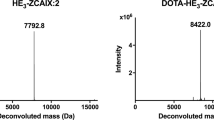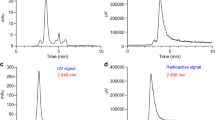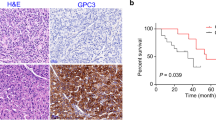Abstract
Purpose
The cluster of differentiation (CD70) is a potential biomarker of clear cell renal cell carcinoma (ccRCC). This study aims to develop CD70-targeted immuno-positron emission tomography/computed tomography (immunoPET/CT) imaging tracers and explore the diagnostic value in preclinical studies and the potential value in detecting metastases in ccRCC patients.
Methods
Four novel CD70-specific single-domain antibodies (sdAbs) were produced and labelled with 18F by the aluminium fluoride restrained complexing agent (AlF-RESCA) method to develop radiotracers. The visualisation properties of the tracers were evaluated in a subcutaneous ccRCC patient–derived xenograft (PDX) model. In a registered prospective clinical trial (NCT06148220), six patients with pathologically confirmed RCC were included and underwent immunoPET/CT examination exploiting one of the developed tracers (i.e., [18F]RCCB6).
Results
We engineered four sdAbs (His-tagged RCCB3 and RCCB6, His-tag-free RB3 and RB6) specifically targeting recombinant human CD70 without cross-reactivity to murine CD70. ImmunoPET/CT imaging with [18F]RCCB3 and [18F]RCCB6 demonstrated a high tumour-to-background ratio in a subcutaneous ccRCC PDX model, with the latter showing better diagnostic potential supported by higher tumour uptake and lower bone accumulation. In comparison, [18F]RB6, developed by sequence optimisation, has significantly lower kidney accumulation than that of [18F]RCCB6. In a pilot translational study, [18F]RCCB6 immunoPET/CT displayed ccRCC metastases in multiple patients and demonstrated improved imaging contrast and diagnostic value than 18F-FDG PET/CT in a patient with ccRCC.
Conclusion
The work successfully developed a series of CD70-targeted immunoPET/CT imaging tracers. Of them, [18F]RCCB6 clearly and specifically identified inoculated ccRCCs in preclinical studies. Clinical translation of [18F]RCCB6 suggests potential for identifying recurrence and/or metastasis in ccRCC patients.







Similar content being viewed by others
Data availability
All the relevant data are available from Prof. W. Wei on rational request.
References
Moch H, Cubilla AL, Humphrey PA, Reuter VE, Ulbright TM. The 2016 WHO classification of tumours of the urinary system and male genital organs—part a: renal, penile, and testicular tumours. European Urol. 2016;70:93–105. https://doi.org/10.1016/j.eururo.2016.02.029.
Dabestani S, Thorstenson A, Lindblad P, Harmenberg U, Ljungberg B, Lundstam S. Renal cell carcinoma recurrences and metastases in primary non-metastatic patients: a population-based study. World J Urol. 2016;34:1081–6. https://doi.org/10.1007/s00345-016-1773-y.
Escudier B, Porta C, Schmidinger M, Rioux-Leclercq N, Bex A, Khoo V, et al. Renal cell carcinoma: ESMO Clinical Practice Guidelines for diagnosis, treatment and follow-up. Ann Oncol. 2019;30:706–20. https://doi.org/10.1093/annonc/mdz056.
Roussel E, Capitanio U, Kutikov A, Oosterwijk E, Pedrosa I, Rowe SP, et al. Novel imaging methods for renal mass characterization: a collaborative review. European Urol. 2022;81:476–88. https://doi.org/10.1016/j.eururo.2022.01.040.
James ML, Gambhir SS. A molecular imaging primer: modalities, imaging agents, and applications. Physiol Rev. 2012;92:897–965. https://doi.org/10.1152/physrev.00049.2010.
Wei W, Rosenkrans ZT, Liu J, Huang G, Luo Q-Y, Cai W. ImmunoPET: concept, design, and applications. Chem Rev. 2020;120:3787–851. https://doi.org/10.1021/acs.chemrev.9b00738.
Verhoeff SR, Oosting SF, Elias SG, van Es SC, Gerritse SL, Angus L, et al. [89Zr]Zr-DFO-girentuximab and [18F]FDG PET/CT to predict watchful waiting duration in patients with metastatic clear-cell renal cell carcinoma. Clin Cancer Res. 2023;29:592–601. https://doi.org/10.1158/1078-0432.Ccr-22-0921.
Hekman MCH, Rijpkema M, Aarntzen EH, Mulder SF, Langenhuijsen JF, Oosterwijk E, et al. Positron emission tomography/computed tomography with (89)Zr-girentuximab can aid in diagnostic dilemmas of clear cell renal cell carcinoma suspicion. Eur Urol. 2018;74:257–60. https://doi.org/10.1016/j.eururo.2018.04.026.
Wei W, Younis MH, Lan X, Liu J, Cai W. Single-domain antibody theranostics on the horizon. J Nucl Med. 2022;63:1475–9. https://doi.org/10.2967/jnumed.122.263907.
Krasniqi A, D’Huyvetter M, Devoogdt N, Frejd FY, Sorensen J, Orlova A, et al. Same-day imaging using small proteins: clinical experience and translational prospects in oncology. J Nucl Med. 2018;59:885–91. https://doi.org/10.2967/jnumed.117.199901.
Morris O, Fairclough M, Grigg J, Prenant C, McMahon A. A review of approaches to 18F radiolabelling affinity peptides and proteins. J Label Compd Radiopharm. 2018;62:4–23. https://doi.org/10.1002/jlcr.3634.
Cleeren F, Lecina J, Bridoux J, Devoogdt N, Tshibangu T, Xavier C, et al. Direct fluorine-18 labeling of heat-sensitive biomolecules for positron emission tomography imaging using the Al18F-RESCA method. Nat Protoc. 2018;13:2330–47. https://doi.org/10.1038/s41596-018-0040-7.
Qin X, Guo X, Liu T, Li L, Zhou N, Ma X, et al. High in-vivo stability in preclinical and first-in-human experiments with [18F]AlF-RESCA-MIRC213: a 18F-labeled nanobody as PET radiotracer for diagnosis of HER2-positive cancers. European J Nucl Med Mol Imaging. 2022;50:302–13. https://doi.org/10.1007/s00259-022-05967-7.
Flieswasser T, Van den Eynde A, Van Audenaerde J, De Waele J, Lardon F, Riether C, et al. The CD70-CD27 axis in oncology: the new kids on the block. J Exp Clin Cancer Res. 2022;41:12. https://doi.org/10.1186/s13046-021-02215-y.
Benhamouda N, Sam I, Epaillard N, Gey A, Phan L, Pham HP, et al. Plasma CD27, a surrogate of the intratumoral CD27-CD70 interaction, correlates with immunotherapy resistance in renal cell carcinoma. Clin Cancer Res. 2022;28:4983–94. https://doi.org/10.1158/1078-0432.Ccr-22-0905.
Jacobs J, Deschoolmeester V, Zwaenepoel K, Rolfo C, Silence K, Rottey S, et al. CD70: An emerging target in cancer immunotherapy. Pharmacol Ther. 2015;155:1–10. https://doi.org/10.1016/j.pharmthera.2015.07.007.
Huang RR, Chen Z, Kroeger N, Pantuck A, Said J, Kluger HM, et al. CD70 is consistently expressed in primary and metastatic clear cell renal cell carcinoma. Clin Genitourin Cancer. 2023. https://doi.org/10.1016/j.clgc.2023.12.003.
Ruf M, Mittmann C, Nowicka AM, Hartmann A, Hermanns T, Poyet C, et al. pVHL/HIF-regulated CD70 expression is associated with infiltration of CD27+ lymphocytes and increased serum levels of soluble CD27 in clear cell renal cell carcinoma. Clin Cancer Res. 2015;21:889–98. https://doi.org/10.1158/1078-0432.CCR-14-1425.
Jilaveanu LB, Sznol J, Aziz SA, Duchen D, Kluger HM, Camp RL. CD70 expression patterns in renal cell carcinoma. Human Pathol. 2012;43:1394–9. https://doi.org/10.1016/j.humpath.2011.10.014.
Li S, Chen D, Guo H, Liu D, Yang C, Zhang R, et al. The novel high-affinity humanized antibody IMM40H targets CD70, eliminates tumors via Fc-mediated effector functions, and interrupts CD70/CD27 signaling. Front Oncol. 2023;13:1240061. https://doi.org/10.3389/fonc.2023.1240061.
Panowski SH, Srinivasan S, Tan N, Tacheva-Grigorova SK, Smith B, Mak YSL, et al. Preclinical development and evaluation of allogeneic CAR T cells targeting CD70 for the treatment of renal cell carcinoma. Cancer Res. 2022;82:2610–24. https://doi.org/10.1158/0008-5472.CAN-21-2931.
Dewulf J, Flieswasser T, Delahaye T, Vangestel C, Miranda A, de Haard H, et al. Site-specific (68)Ga-labeled nanobody for PET imaging of CD70 expression in preclinical tumor models. EJNMMI Radiopharm Chem. 2023;8:8. https://doi.org/10.1186/s41181-023-00194-3.
Ziaei V, Ghassempour A, Davami F, Azarian B, Behdani M, Dabiri H, et al. Production and characterization of a camelid single domain anti-CD22 antibody conjugated to DM1. Mol Cell Biochem. 2023. https://doi.org/10.1007/s11010-023-04741-z.
Zhang X, Liu C, Xie Y, Hu Q, Chen Y, Li J. Identification and characterization of blocking nanobodies against human CD70. Acta Biochim Biophys Sin (Shanghai). 2022;54:1518–27. https://doi.org/10.3724/abbs.2022141.
Cleeren F, Lecina J, Bridoux J, Devoogdt N, Tshibangu T, Xavier C, et al. Direct fluorine-18 labeling of heat-sensitive biomolecules for positron emission tomography imaging using the Al(18)F-RESCA method. Nat Protoc. 2018;13:2330–47. https://doi.org/10.1038/s41596-018-0040-7.
Dandekar M, Tseng JR, Gambhir SS. Reproducibility of <sup>18</sup>F-FDG microPET studies in mouse tumor xenografts. J Nucl Med. 2007;48:602–7. https://doi.org/10.2967/jnumed.106.036608.
Barata PC, Rini BI. Treatment of renal cell carcinoma: current status and future directions. CA: A Cancer J Clin. 2017;67:507–24. https://doi.org/10.3322/caac.21411.
Wu Q, Huang G, Wei W, Liu J. Molecular imaging of renal cell carcinoma in precision medicine. Mol Pharm. 2022;19:3457–70. https://doi.org/10.1021/acs.molpharmaceut.2c00034.
Pal SK, Forero-Torres A, Thompson JA, Morris JC, Chhabra S, Hoimes CJ, et al. A phase 1 trial of SGN-CD70A in patients with CD70-positive, metastatic renal cell carcinoma. Cancer. 2019;125:1124–32. https://doi.org/10.1002/cncr.31912.
Yang M, Tang X, Zhang Z, Gu L, Wei H, Zhao S, et al. Tandem CAR-T cells targeting CD70 and B7–H3 exhibit potent preclinical activity against multiple solid tumors. Theranostics. 2020;10:7622–34. https://doi.org/10.7150/thno.43991.
Tannir NM, Forero-Torres A, Ramchandren R, Pal SK, Ansell SM, Infante JR, et al. Phase I dose-escalation study of SGN-75 in patients with CD70-positive relapsed/refractory non-Hodgkin lymphoma or metastatic renal cell carcinoma. Investig New Drugs. 2014;32:1246–57. https://doi.org/10.1007/s10637-014-0151-0.
Owonikoko TK, Hussain A, Stadler WM, Smith DC, Kluger H, Molina AM, et al. First-in-human multicenter phase I study of BMS-936561 (MDX-1203), an antibody-drug conjugate targeting CD70. Cancer Chemother Pharmacol. 2015;77:155–62. https://doi.org/10.1007/s00280-015-2909-2.
Massard C, Soria J-C, Krauss J, Gordon M, Lockhart AC, Rasmussen E, et al. First-in-human study to assess safety, tolerability, pharmacokinetics, and pharmacodynamics of the anti-CD27L antibody-drug conjugate AMG 172 in patients with relapsed/refractory renal cell carcinoma. Cancer Chemother Pharmacol. 2019;83:1057–63. https://doi.org/10.1007/s00280-019-03796-4.
Aftimos P, Rolfo C, Rottey S, Offner F, Bron D, Maerevoet M, et al. Phase I dose-escalation study of the anti-CD70 Antibody ARGX-110 in advanced malignancies. Clin Cancer Res. 2017;23:6411–20. https://doi.org/10.1158/1078-0432.Ccr-17-0613.
Riether C, Pabst T, Höpner S, Bacher U, Hinterbrandner M, Banz Y, et al. Targeting CD70 with cusatuzumab eliminates acute myeloid leukemia stem cells in patients treated with hypomethylating agents. Nat Med. 2020;26:1459–67. https://doi.org/10.1038/s41591-020-0910-8.
Flieswasser T, Camara-Clayette V, Danu A, Bosq J, Ribrag V, Zabrocki P, et al. Screening a broad range of solid and haematological tumour types for CD70 expression using a uniform IHC methodology as potential patient stratification method. Cancers. 2019;11. https://doi.org/10.3390/cancers11101611.
Duclos V, Iep A, Gomez L, Goldfarb L, Besson FL. PET molecular imaging: a holistic review of current practice and emerging perspectives for diagnosis, therapeutic evaluation and prognosis in clinical oncology. International J Mol Sci. 2021;22. https://doi.org/10.3390/ijms22084159.
An S, Zhang D, Zhang Y, Wang C, Shi L, Wei W, et al. GPC3-targeted immunoPET imaging of hepatocellular carcinomas. European J Nucl Med Mol Imaging. 2022;49:2682–92. https://doi.org/10.1007/s00259-022-05723-x.
Zhang Y, Zhang D, An S, Liu Q, Liang C, Li J, et al. Development and characterization of nanobody-derived CD47 theranostic pairs in solid tumors. Research. 2023;6:0077. https://doi.org/10.34133/research.0077.
Chatalic KLS, Veldhoven-Zweistra J, Bolkestein M, Hoeben S, Koning GA, Boerman OC, et al. A novel 111In-labeled anti–prostate-specific membrane antigen nanobody for targeted SPECT/CT imaging of prostate cancer. J Nucl Med. 2015;56:1094–9. https://doi.org/10.2967/jnumed.115.156729.
D’Huyvetter M, Vincke C, Xavier C, Aerts A, Impens N, Baatout S, et al. Targeted radionuclide therapy with A 177Lu-labeled anti-HER2 nanobody. Theranostics. 2014;4:708–20. https://doi.org/10.7150/thno.8156.
Yang E, Liu Q, Huang G, Liu J, Wei W. Engineering nanobodies for next-generation molecular imaging. Drug Discovery Today. 2022;27:1622–38. https://doi.org/10.1016/j.drudis.2022.03.013.
Funding
This work was supported in part by the National Key Research and Development Program of China (Grant No. 2020YFA0909000), the National Natural Science Foundation of China (Grant No. 82372014), and the Shen Kang-United Imaging Joint Research and Development Plan (Grant No. SKLY2022CRT301).
Author information
Authors and Affiliations
Contributions
W. Wei, W. Zhai and J. Liu conceptualised and designed the study methodology. Q. Wu, Y. Zhang, and Y. Wu conducted experiments and performed visualisation work. J. Liu, G. Huang, and Y. Guan were responsible for project administration and supervised the study. W. Wei, Q. Wu, and Y. Wu wrote the original manuscript draft, while others contributed to the writing. W. Wei and W. Zhai reviewed, edited, and finalised the manuscript. All authors read and approved the final manuscript.
Corresponding authors
Ethics declarations
Ethics approval
All animal imaging studies were approved by the Institutional Committee for the Care and Use of Animals (Renji Hospital, Shanghai Jiao Tong University School of Medicine). The clinical study was approved by the Institutional Ethical Reviewing Board of Huashan Hospital and registered as a prospective clinical trial (ClinicalTrials.gov ID NCT06148220).
Consent to participate
Written informed consents were obtained from all the included patients.
Consent to publish
All the participants agreed to the publication of the imaging data.
Competing interests
W. Wei is a consultant of Alpha Nuclide (Ningbo) Medical Technology Co., Ltd. W. Wei, Q. Wu, and J. Liu are co-inventors of three pending patents describing the disclosed imaging technologies.
Additional information
Publisher's Note
Springer Nature remains neutral with regard to jurisdictional claims in published maps and institutional affiliations.
Supplementary Information
Below is the link to the electronic supplementary material.
Rights and permissions
Springer Nature or its licensor (e.g. a society or other partner) holds exclusive rights to this article under a publishing agreement with the author(s) or other rightsholder(s); author self-archiving of the accepted manuscript version of this article is solely governed by the terms of such publishing agreement and applicable law.
About this article
Cite this article
Wu, Q., Wu, Y., Zhang, Y. et al. ImmunoPET/CT imaging of clear cell renal cell carcinoma with [18F]RCCB6: a first-in-human study. Eur J Nucl Med Mol Imaging (2024). https://doi.org/10.1007/s00259-024-06672-3
Received:
Accepted:
Published:
DOI: https://doi.org/10.1007/s00259-024-06672-3




